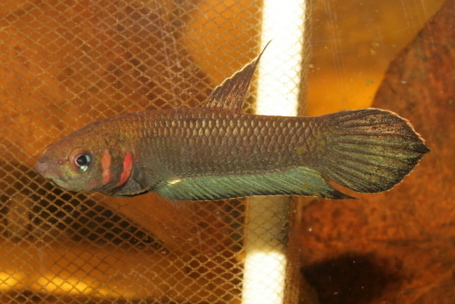Both looks male. These guys are very good jumpers. Better to cover your tank.

Hi everyone,
Got these two Betta mandor from C328 on Wednesday. These are my first mouthbrooders. I was hoping that I'd have a pair, but the more I look at them, the more I think I have two males.
Their in a 1.5' tank. The smaller one is separated in a breeding net, because it was getting harassed too much.
This is the larger fish. Haven't got a closer picture yet.
This is the one I thought is female. Looks very male, doesn't it? The red opecular scales indicate it's a male right?
Any input or advice on these fish? Sorry the pictures aren't good.
Cheers,
Enda

Both looks male. These guys are very good jumpers. Better to cover your tank.
Eugene (^_^)
De Dwergcichlide Fanatiek
Now swimming: Plecos and Apistogrammas







We have had these in at work for ages. I dont think those are mandor. At least not very well coloured up.
Also, i dont believe in this gold and red bars means male and female. Strohi often have gold bars, and mandor usually only red. These species are often confused, but both of those fish are male.
We had 30 male mandor sent, and ordered 20 females after, they sent 10 strohi. Very hard to find females for these it seems.
Nice fish when they colour up though.
Currently keeping many wild betta species and other anabantoids.

Thanks for your input guys. So all we're certain of is that I have two male fish.
Mez, do you have any mandor photos to share? Just to clarify, both fish have red opercular scales. I've read that the males have red and females have yellow/gold ones. Does this agree with your experience?We have had these in at work for ages. I dont think those are mandor. At least not very well coloured up.
Also, i dont believe in this gold and red bars means male and female. Strohi often have gold bars, and mandor usually only red. These species are often confused, but both of those fish are male.
I'm keeping the fish in pretty dark water now, using ketapang leaves, and my lousy photography doesn't do justice to their actual appearance. The fish have settled down more. The larger one has really coloured up. It has a slight hint of blue, especially on the anal fin. As you can see from the photos, it has a gold edge to the dorsal and caudal fins.
The smaller fish doesn't have as intense colour. It sometimes shows the distinct banded pattern you see in the photo below, which I assume is a stress pattern.
Any other suggestions?
Last edited by Enda; 25th May 2009 at 13:24.

Here are some updated pictures of the Betta mandor. The dominant male has really coloured up, with this blue-green sheen on the caudal and anal fins.

I saw one big bag of mandors at C328 yesterday.. I really likes them but no idea how to choose a pair...
Maybe you can go get a female?
Cheers,
http://www.aquaticquotient.com/forum...c/progress.gif"Ben"
http://www.aquaticquotient.com/forum...c/progress.gif
Life is all about patience & perseverance,
Failure is just another new beginning

Yup I did get one from this batch, but I think it's a male too. It doesn't look like there are any females at all. I have a feeling that the collectors may have chosen only males for export.
From the description, females have markedly shorter fins: dorsal fin not reaching the base of the caudal fin, and anal fin not extending beyond halfway mark of caudal fin. The fish that come in are not always easy to sex, given that many have damaged fins, and their colours are washed out due to stress. Some are obviously male, but females are difficult to pick out.
Thanks anyway!
Cheers,
http://www.aquaticquotient.com/forum...c/progress.gif"Ben"
http://www.aquaticquotient.com/forum...c/progress.gif
Life is all about patience & perseverance,
Failure is just another new beginning

I saw hat big bag,looks like all male to me.Some have nice colouration despite been kept in bag.
Love all,Trust few,Do wrong to none
Bookmarks